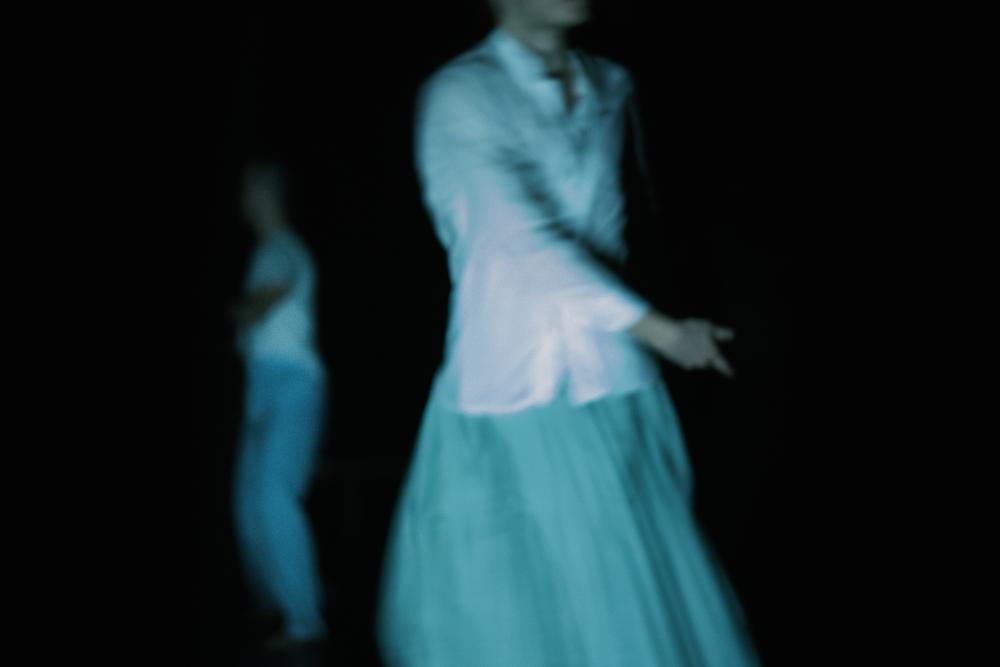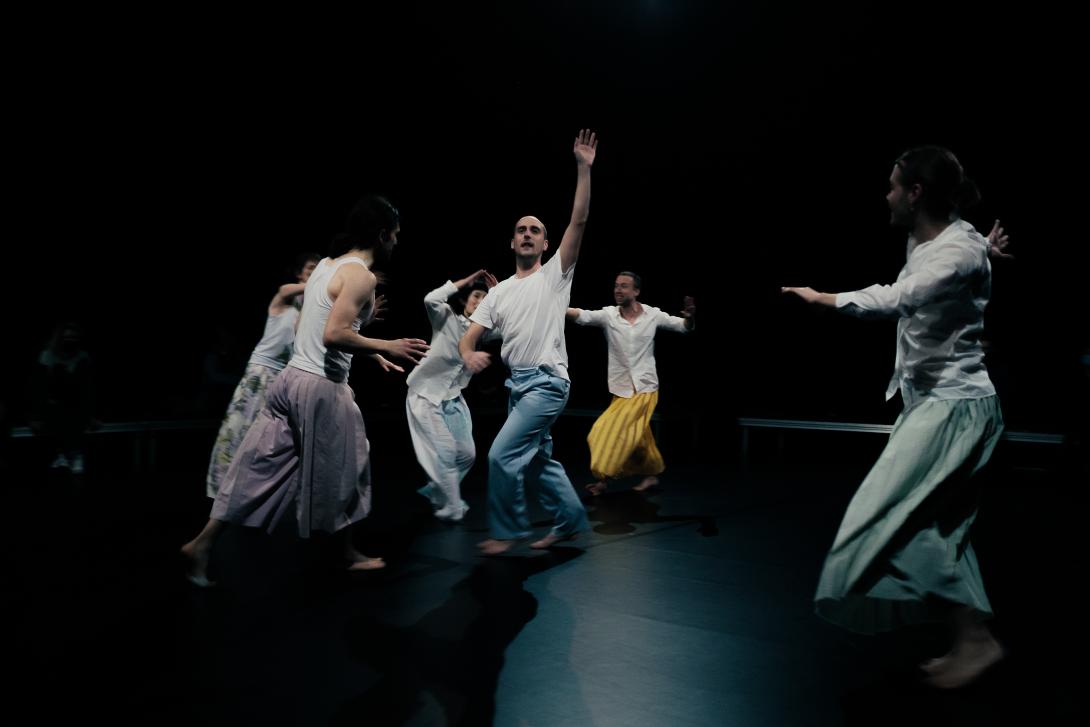| Mon | Tue | Wed | Thu | Fri | Sat | Sun |
|---|---|---|---|---|---|---|
|
1
|
2
|
3
|
4
|
5
|
6
|
7
|
|
8
|
9
|
10
|
11
|
12
|
13
|
14
|
|
15
|
16
|
17
|
18
|
19
|
20
|
21
|
|
22
|
23
|
24
|
25
|
26
|
27
|
28
|
|
29
|
30
|
31
|
|
|
|
|
Read more - Listen Here: This Cavern
Here you find a short description of the performance and the credits.
DANCE IS A STATE OF CONSCIOUSNESS
text by Lieve Dierckx
Can we reach a state in which “dancing” and “giving attention” mean the same thing?
What is dance and what is dance actually about? That is, in short, the question around which Daniel Linehan has been building his choreographic oeuvre since 2003. When he christened his Brussels-based organisation ‘Hiatus’, he had already explored the area shared by dance, text, voice and video. He investigated everything outside of that as a sort of photographic negative, in Not About Everything (2007), for example, where he revolves in a long-drown ritual in the centre of a circle of papers with text while explaining what he doesn’t want to talk about: not about himself, not about politics, not about hope, not about virtuosity and not about social unrest.
He still believes that the calm offered by this negative is badly needed. As he says in the introduction to This Cavern, the second part of Listen Here, ‘The world in which we live is extremely complicated and crammed with a huge amount of information. Instead of adding more content with my productions, I want us to empty ourselves and allow an opening in the dance itself, in which the performers and the audience can take the time to listen and reflect.’
At the same time, that spirit in his work has brought about a transformation over the years: the audience and the external world are brought closer.
‘Rather than a choreographer, I increasingly see myself as someone who accompanies ‘here-and-now’ experiences, in rehearsals with dancers, in my performances on stage and in more open formats. In that perspective, the connection between the different activities we undertake with Hiatus has become clearer to me.’
As well as his theatre work, Linehan organises, for example, Land Connection Practices in the open air with Michael Helland, to which everyone is welcome, or Open Mondays, where dancers share their movement practices with professionals and amateurs alike. Linehan and Helland also present these as longer workshops under the title Tending and Tuning. Whether it is inside or outside, it’s always about listening to the surroundings and your body.
Linehan’s new two-part Listen Here can be described as one big listening ear grafted onto his experience with the practice of Deep Listening established by the visionary composer Pauline Oliveros (1935-2016). Linehan participated in a retreat in 2020 with some of her collaborators who are continuing to apply her philosophy: ‘We listened to our dreams, to our breath. We listened with our eyes, with our skin. We worked with Qigong to hear our bodies better. In that sort of activated openness you become more sensitive to your surroundings and all the different living beings around you.’
The relationship between vulnerable life and a fragile planet as a theme in Linehan’s work has become more prominent since he started working with his performers on eco- philosophy for sspeciess (2020). In his solo Body of Work (2019), Linehan also makes use of the ecological memory of his own body. He zooms in on the movement stored in his body after 15 years as a choreographer, and he goes even further back to his childhood in Seattle (US). He has never been so close to his audience before: in the square around the stage he lays his memories literally at their feet.
The solo was also the start for the first of the two-part Listen Here, in which the primaeval forests, mountains and rivers from where he was born in the north-west of the United States resonate. For this site-specific production, a collaboration with BOS+, Linehan and five performers entered the woods, each with a group of spectators, on a silent walk to open up all the senses - toward the trees, the wind, the birds and the sounds of the surroundings - by means of small tasks. ‘In this touch/In this moment/In this body/In this earth’: the text on the dancers’ sweatshirts could be read as a manifesto. The dancers improvised in a clearing in the woods with the input they received from nature (of which the spectator is also a part). For those interested, Michael Hellend also led a workshop to help spectators tune into the relationship between the trees, their bodies and each other.
In Listen Here: This Cavern Linehan turns inwards with the same performers: Renaud Dallet, Gorka Gurrutxaga Arruti, Anneleen Keppens, Jean-Baptiste Portier and Louise Tanoto. The two-part production thus follows the cyclical rhythm of the seasons, of light and darkness, of consideration for the visible world to what takes place in the darkness under the earth’s surface, where billions of kilometres of mycelial networks absorb carbon and sustain the roots that we could not see in the woods.
In Listen Here: This Cavern, the performers turn the cave into one enormous sensory space where the spectator can return to themselves. Between the half-light and darkness, we hear waves and stones, text and the sound of the voice, we feel the air move, smell a cleansing herb. It is in this soundscape that Pauline Oliveros is very present with her 1988 improvisation Deep Listening. Whilst alive, she performed in the gigantic subterranean water reservoir of an old fort in Port Townsend, Washington; a place where each note echoed for 45 seconds, notes from her own accordion, from Stuart Dempster’s trombone and from the vocalist Panaiotis. She then travelled all over the world with the Deep Listening Band playing the specific, energetic spaciousness of sound in caves, cathedrals and other resonant locations. Three years later she started her Deep Listening Retreats.
Just like Oliveros, Linehan’s goal in Listen Here: This Cavern is transformation. We immerse ourselves together in a shared place of ritual and raised consciousness.
‘In This Cavern we turn inwards, literally and figuratively. Using the texts that we wrote in the creative process, we take the spectator to the living tissue of the innermost of our body, to the lungs, the heart, the digestive system; we feel the microbes and bacteria swarming’, said Linehan. This Cavern is not a claustrophobic place for him, but a warm womb in which life can grow, where mystical realities and myths are nourished; the cavern as a place of inquiry, even about the significance of dance and movement.
The cave as place for questioning the meaning of dance and movement, among others. Why did our distant ancestors come together to paint animals on the walls? What did their rituals look like? How did they move, what did it mean? From the square of the audience’s benches we find traces of these questions in the performers’ movement material: we see them transform from an amorphous mass into apparitions in an interplay of circles and spirals between heaven and earth.
Circling the spectators at a distance, Linehan himself adopts the role in This Cavern of master of ceremonies, reader and shaman - a guide to a profound experience.

